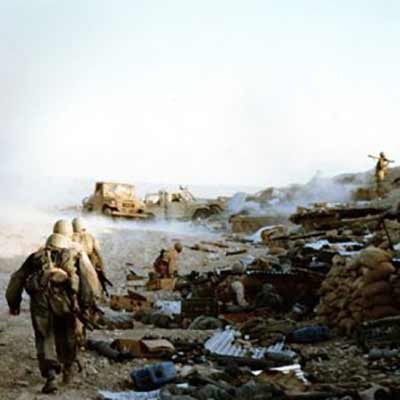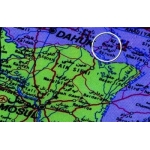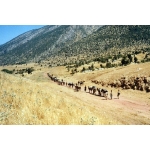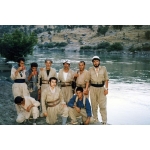Operation Fath-8
Masuma Sajjadian
286 بازدید
Iran's Islamic Revolutionary Guard Corps carried out Operation Fath-8 in 1987 with the aim of destroying the Iraqi army in Mosul, Iraq.
Operation Fath-8 was carried out in the evening of July 18, 1987. It aimed at destroying Iraq’s facilities and military bases in the northern region and supporting the Kurdish opposition factions (Patriotic Union of Kurdistan).[1]
Following the success of Operation Fath-7, which was carried out in Halabja on June 25, 1987, under the command of the Ramadan Base, Operation Fath-8 was a response to the chemical bombing of Sardasht in West Azerbaijan on June 28, 1987, and the bombing and destruction of Kurdish villages in northern Iraq and to support the struggle of the Muslims within Iraq.[2] Operation Fath-8 is known as the "deepest commando operation within Iraq" in terms of distance.[3]
This operation was conducted by forces under the command of the Ramadan Base, which consisted of the IRGC Special Airborne Brigade, the 66th Malik Ashtar Brigade and the Iraqi Kurdistan Islamic Brigade. Operation Fath-8 started on July 18, 1987 with the codename “Ya Rasulullah” at a depth of 150 kilometers within Iraq. In this operation, the city of Atroosh, north of Mosul, was attacked. This city was the most important military center of the Baathist regime in this region and was protected by three strong forts. The forces under the command of the Ramadan Base traveled a three-hundred-kilometer route to infiltrate this mountainous region. They entered the city after a heavy battle. In the first stage of the operation, they were able to capture the strategic fortress of Kanika, located nine kilometers northeast of Atroosh. This fortress controlled fifteen military bases around Atroosh. During the seven-hour occupation of the city and the control of the roads leading to it, the Iranian forces destroyed the security and military centers of the city, including the intelligence headquarters, the district headquarters, the Baath Party communications center, and the Jaish al-Shaabi headquarters, which were the main bases suppressing the people of the region, especially the cities of Aqra and Sheikhan Further, the Atashbar Artillery Center and Atroosh Artillery were attacked and all their cannons and equipment were destroyed. In the continuation of this operation, three forts around the city and the military bases of the region were completely destroyed.[4]
Following these strikes, the Iraqi army sent two battalions of its special forces to fight, but before taking any action, the forces of the Ramadan camp disrupted their combat organization and fled the operational area with casualties.[5] During the enemy attack, a personnel carrier and a 106 cannon were also destroyed.[6]
In this operation, two hundred military and security forces, including Abdul Ayyar Hassan Ramadan, one of the intelligence officials of Atroosh, were killed, while 350 were injured. Ali Atroosh, the head of the Jashhai (Kurds allied with the Iraqi government), was among the wounded. Thirty people were also captured.[7]
In this operation, more than forty security bases and headquarters were destroyed. Thirty-five light and heavy vehicles, an ammunition warehouse, three vehicles carrying ammunition, three 155- and 122-mm cannons, seven mortars and two four-barrel anti-aircraft guns were also destroyed. A large amounts of weapons and ammunition,[8] including all types of light and medium weapons, were seized.[9]
One of the commanders of the Operation Fath-8 said that the continuation of the resistance of the people in northern Iraq, in addition to the irreparable losses and damages inflicted on the Iraqi regime, led to the liberation of a large part of the northern areas of Iraq. This allowed them to extend the scope of their struggles to the south of the country, where revolutionary and partisan operations were witnessed. After the operation, in a conversation with the Islamic Republic News Agency, referring to the Iraqi regime's denial of Operation Fath-8, a commander asked the representatives of the foreign media based in Baghdad to visit the destroyed bases in the city of Atroosh.[10] In continuing the series of conquest operations, Operation Fath-9 was carried out on August 3, 1987, in the Kharmal region of Iraq.[11]
[1] Habibi, A., The Operations Record of Islamic Guards in Eight Years of Holy Defense, Tehran: Public Relations and IRGC Publications Department, p. 178.
[2] Lotfollahzadegan, A., History of the Iran-Iraq War, Book 49: Approval of Resolution 598, Political and Military Fields, Tehran: IRGC War Studies and Research Center, 2007, pp. 327 and 353; Journal of the Islamic Republic, No. 2360, July 20, 1987, p. 2.
[3] The deepest commando operation in Iraq, Hamshahri Online, Sunday, July 18, 2016.
[4] Islamic Republic newspaper, ibid., p. 2; Lotfollahzadegan, A., Journal of the Iran-Iraq War, Book 49, p. 684.
[5] Ibid, Islamic Republic newspaper.
[6] Lotfollahzadegan, A., Journal of the Iran-Iraq War, Book 49, p. 684.
[7] Ibid
[8] Samii, A., Descriptive record of the operations of Islamic warriors during the eight years of holy defense, Tehran: Vice-President of Propaganda and Publications of Vali Faqih Representation in the Ground Force, 1997, p. 349.
[9] Ibid., Islamic Republic newspaper,
[10] Ibid
[11] Yazdanfam, M., Journal of the Iran-Iraq War, Book 50: Escort of Oil Tankers, Tehran: IRGC War Studies and Research Center, 1999, p. 202 and the map at the end of the book; Newspaper of the Islamic Republic, No. 2376, August 9, 1987, p. 2.








